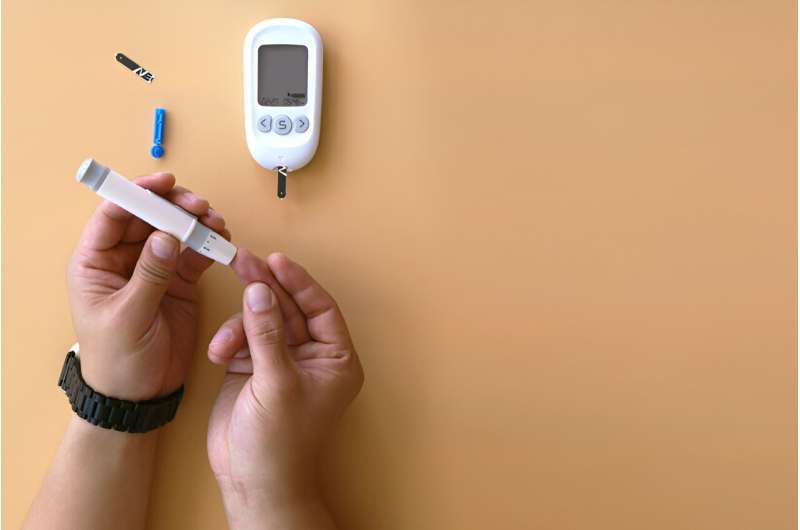This article has been reviewed according to Science X's editorial process and policies. Editors have highlighted the following attributes while ensuring the content's credibility:
fact-checked
trusted source
proofread
Air pollution exposure early in pregnancy increases gestational diabetes risk, study finds

Exposure to air pollution early in pregnancy—and even shortly before conception—increases a woman's risk of developing gestational diabetes, according to a new USC study out in The Lancet Regional Health—Americas.
Gestational diabetes usually goes away after childbirth, but it can cause problems during pregnancy. For the mother, it increases the risk of high blood pressure and preeclampsia. For the baby, it can lead to larger birth weight, a higher chance of delivery by cesarean section and greater risk of obesity in the future.
"Interestingly, we found gestational diabetes risk wasn't associated with long-term air pollution exposure but was associated with air pollution in a relatively short but critical periconceptional window, from five weeks before to five weeks after conception," said first author Zhongzheng "Jason" Niu, a postdoctoral fellow in population and public health science at the Keck School of Medicine of USC.
"During the menstrual cycle, in preparation for pregnancy, a woman's body goes through significant physiological changes, especially in how it handles glucose to support fetal growth. This dynamic period of metabolic adaptation may increase the mother's susceptibility to environmental insults."
For the study, researchers drew 617 participants from the Maternal and Developmental Risks from Environmental and Social Stressors (MADRES) study, an ongoing prospective pregnancy cohort study established in 2015. Participants, predominately Hispanic, were patients at clinical sites that serve low-income populations in Los Angeles.
Niu and his colleagues correlated residential addresses with EPA ambient air quality data. Specific pollutants on the watchlist were those typically associated with traffic: fine particle pollutants PM2.5 and PM10 as well as nitrogen dioxide and ozone.
Study focuses on gestational diabetes and air pollution
Of the 617 participants, 60 developed gestational diabetes. The study found that exposure to air pollutants during the critical periconceptional window was associated with an increased risk of gestational diabetes, by 5.7% for PM2.5, 8.9% for PM10 and 15% for nitrogen dioxide.
The researchers also found the association between air pollution and gestational diabetes was more pronounced among study participants experiencing prenatal depression. Prenatal depression, already a concern for its potential impact on both mother and child, appears to amplify the effects of air pollution exposure.
"Our research indicates that women with symptoms of prenatal depression are even more vulnerable to the adverse effects of air pollution," said senior author Shohreh Farzan, an associate professor of population and public health sciences at the Keck School of Medicine. "This underscores the importance of developing more holistic health care approaches that consider both mental and environmental factors during pregnancy. Addressing prenatal depression not only benefits maternal mental health but may also buffer against environmental risks like air pollution."
Unclear what connects gestational diabetes and ambient air pollution
The mechanism connecting ambient air pollution and gestational diabetes remains unclear, researchers say, but an interplay among impaired glucose metabolism, inflammation and hormonal changes could be to blame. Prenatal depression, with disrupted immune and hormonal functions, could make the case worse.
One theory is that air pollution exposures trigger oxidative stress in the respiratory tract, Farzan said, leading to chronic inflammation throughout the body, with exhausted antioxidant defenses over time. This disrupts insulin signaling pathways and limits glucose-consuming cells from healthy intake of circulating glucose.
"We suspect air pollution, particularly for exposure in a defined period of the eight weeks from last menstrual period through the first few weeks of pregnancy, could disrupt physiological adaptations during early pregnancy that may predispose the pregnant women to an increased risk of gestational diabetes," said Farzan.
"Even though the overall levels of air pollution observed in the study were within guidelines, these levels still present significant health risks. This underscores the need to reevaluate the adequacy of existing air quality standards to ensure the well-being of expectant mothers and their unborn children."
More information: Zhongzheng Niu et al, Preconceptional and prenatal exposure to air pollutants and risk of gestational diabetes in the MADRES prospective pregnancy cohort study, The Lancet Regional Health—Americas (2023). DOI: 10.1016/j.lana.2023.100575




















